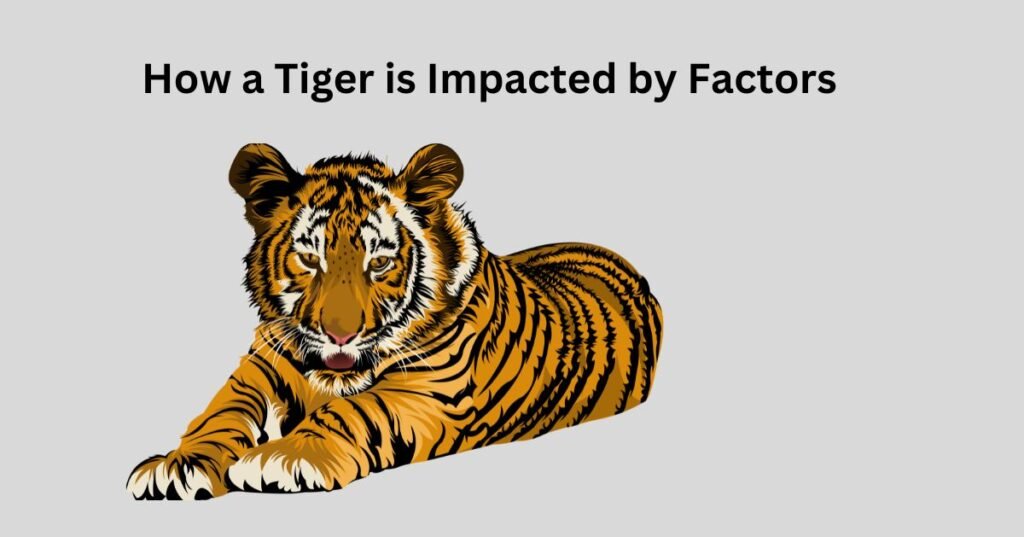Tigers, with their striking beauty and immense power, are one of nature’s most formidable predators. However, these magnificent creatures face a wide range of threats that undermine their survival in the wild. From habitat loss and poaching to climate change and human-wildlife conflict, each of these factors plays a pivotal role in influencing tiger populations. This article delves deep into the various factors that impact tigers, detailing the consequences of each and the efforts being made to conserve these endangered animals.
Habitat Loss and Fragmentation
Habitat loss is one of the most critical factors affecting tiger populations worldwide. As human populations continue to expand, forests and jungles that once provided a safe home for tigers are being cleared for agricultural purposes, urban development, and infrastructure projects. Tigers rely on expansive, contiguous forests to hunt, breed, and roam, and when these habitats are fragmented, their survival becomes increasingly difficult.
One of the main consequences of habitat fragmentation is the reduction in prey availability. Tigers, being apex predators, require large amounts of prey to sustain their energy and health. Habitat destruction can significantly decrease the availability of prey species, forcing tigers to travel longer distances in search of food, which increases their exposure to danger and reduces their chances of survival.
Moreover, fragmented habitats also create isolated pockets of tiger populations. These isolated populations often suffer from inbreeding, which reduces genetic diversity and weakens the overall health of the species. A lack of genetic variation makes tigers more susceptible to diseases and less adaptable to environmental changes. Additionally, smaller populations may face greater competition for resources, further straining their chances of thriving in a rapidly changing environment.
Poaching and Illegal Wildlife Trade
Poaching remains one of the most direct and devastating threats to tigers. Despite international efforts to curb illegal hunting, tigers continue to be killed for their skins, bones, and other body parts, which are highly valued in black markets for use in traditional medicine, luxury items, and souvenirs. This illegal wildlife trade has been a driving force behind the decline of tiger populations, especially in countries where enforcement of wildlife protection laws is weak.
The impact of poaching on tiger populations is severe. Not only does it directly reduce the number of tigers in the wild, but it also disrupts the natural balance of ecosystems. As apex predators, tigers play a critical role in regulating prey species and maintaining the health of their habitats. Without tigers, prey populations can grow uncontrollably, leading to overgrazing and the degradation of ecosystems.
Furthermore, poaching leads to the loss of genetically diverse individuals within tiger populations. When poachers target specific tigers, such as those with unique physical characteristics or those in remote areas, it reduces the genetic diversity within the population, increasing the likelihood of inbreeding and diminishing the species’ ability to adapt to new environmental conditions.
Climate Change and Environmental Disruptions
Climate change has emerged as an increasingly significant threat to tigers, as it exacerbates many of the challenges they already face. Rising temperatures, shifting rainfall patterns, and extreme weather events such as floods and droughts can have profound effects on tiger habitats and prey species. For example, in the Sundarbans region of India and Bangladesh, the Bengal tiger’s habitat is increasingly threatened by rising sea levels and coastal flooding, which cause the loss of critical mangrove forests.
Changes in the climate can also affect prey populations, as shifts in temperature and weather patterns impact the availability of food sources for tigers. Droughts, for instance, can reduce the number of herbivores in an area, making it harder for tigers to find food. On the other hand, floods can inundate the tiger’s territory, forcing them to migrate and often resulting in dangerous encounters with human populations or other animals.
Furthermore, as climate change alters the natural environment, tigers may be forced to move into new areas in search of suitable habitats, which can increase the risk of human-wildlife conflict. Displacement often leads to tigers entering human-dominated landscapes, where they may prey on livestock or come into direct contact with people, resulting in retaliation or accidental killings.
Human-Wildlife Conflict
Human-wildlife conflict is another significant factor impacting tiger populations. As human settlements expand into tiger habitats, the likelihood of encounters between tigers and humans increases. Tigers are often driven to seek food in areas near human settlements, where they may prey on livestock such as cattle, goats, and poultry. In retaliation, farmers and local communities may resort to killing or poisoning tigers, either to protect their livestock or out of fear of potential attacks on humans.
This conflict is particularly severe in areas where tigers have been pushed to the edges of their natural habitats, often due to habitat destruction or the encroachment of human settlements. In such cases, tigers may feel threatened or stressed, and their natural behaviors may be altered. As a result, they may venture into human-populated areas in search of food, which not only puts their lives at risk but also exacerbates tensions between local communities and conservationists.
In some cases, tigers are also killed or captured when they pose a perceived threat to human life. This is especially true in areas where tiger populations are growing in proximity to human settlements. As human populations encroach further into tiger habitats, the risk of conflict continues to rise, placing both humans and tigers in increasingly perilous situations.
Diseases and Health Challenges
Tigers, like all wildlife, are susceptible to diseases that can severely affect their health and reproductive success. In the wild, they are exposed to a variety of pathogens, ranging from viral infections to parasitic diseases. However, the spread of diseases is often exacerbated by human activities such as habitat fragmentation and the introduction of domestic animals into tiger habitats.
For instance, tigers in some regions have contracted diseases such as canine distemper and tuberculosis from domestic dogs and livestock. These diseases can have devastating effects on tiger populations, causing illness and death, and in some cases, leading to the collapse of entire tiger populations. The impact of diseases on tigers is particularly pronounced in areas where human encroachment has brought wild tigers into contact with domestic animals, increasing the risk of cross-species transmission.
Additionally, the stress caused by habitat loss, human-wildlife conflict, and poaching can weaken a tiger’s immune system, making it more vulnerable to infections and diseases. Stress is known to suppress the immune response, and as tigers face mounting challenges, their health deteriorates, leading to further population declines.
Conservation Efforts and Protected Areas
While the challenges facing tigers are significant, there is hope. Conservation efforts have led to some positive outcomes, with many countries implementing measures to protect tiger populations. Protected areas such as national parks, wildlife sanctuaries, and reserves provide safe havens for tigers, free from the threat of poaching and human encroachment. These areas allow tigers to live and breed in relative safety, ensuring the survival of their species.
Anti-poaching initiatives, including increased patrols and the use of technology such as camera traps and drones, have been successful in reducing poaching in certain regions. In addition, many countries have strengthened laws and enforcement mechanisms to combat wildlife crime, resulting in higher penalties for poachers and greater protection for endangered species.
Captive breeding programs have also played a role in tiger conservation. These programs are designed to breed tigers in controlled environments and eventually release them into the wild, boosting the genetic diversity and population of wild tigers. While such programs are controversial and not without challenges, they represent a step toward restoring tiger populations in areas where they are critically endangered.
Conclusion
Tigers are facing a multitude of challenges that threaten their survival, from habitat destruction and poaching to climate change and human-wildlife conflict. These factors not only endanger the tigers themselves but also disrupt the delicate balance of the ecosystems they inhabit. However, concerted conservation efforts, legal protections, and increasing awareness are helping to mitigate some of these threats.
Ultimately, the future of tigers hinges on our ability to protect their habitats, combat poaching, and reduce human-wildlife conflict. By addressing these issues head-on, we can ensure that tigers continue to roam the wild for generations to come, maintaining their role as apex predators and vital contributors to the health of their ecosystems.



